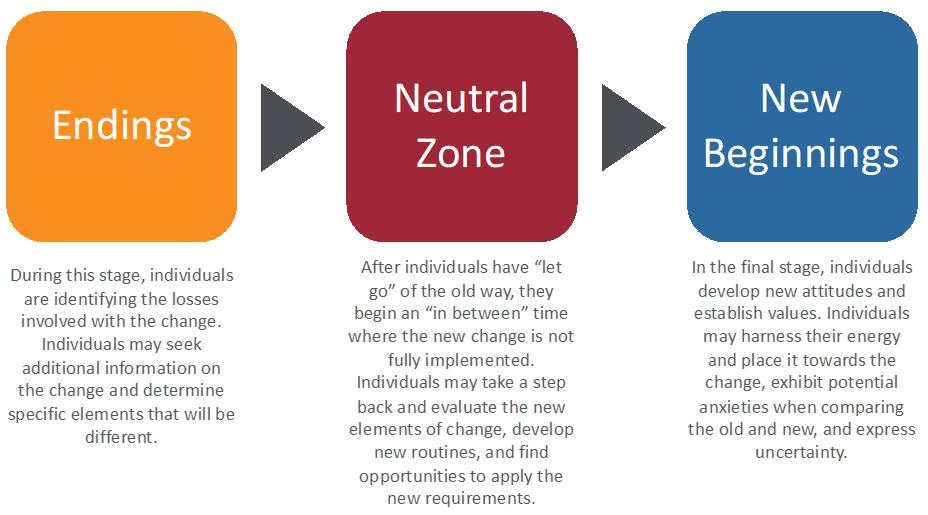Reacting to Change and Resistance
June 4, 2020 in Keeping Up with Human Capital
By Carolyn Kurowski, Marni Falcone, Beth Chidester
The current pandemic has required us all to change how we do work. Whether you are working virtually from home or going into an office wearing a mask and keeping a safe distance from your coworkers, the change has been significant. Change is inevitable and oftentimes met with resistance. Being aware of how you and others react to and deal with change can help you successfully navigate and overcome resistance. Because there is so much to unpack about change, we have broken our blog into two parts. Part 1 will focus on ourselves and reflecting on how we react to and deal with change and in Part 2, we will take an organizational perspective aimed at how leaders can create a positive culture for change.
Let’s start with a simple exercise. Cross your fingers, legs, or arms one way. Then, cross them the other way for a bit longer. How did crossing the other way make you feel? Odds are, it felt awkward or uncomfortable at first and you wanted to switch back to the original way. But, you probably got used to it as time went on. Now, if I were to ask you to cross your fingers, legs or arms again, starting with the unnatural, opposite side, you might have to stop and think for a moment about how to cross them the other way and then, reluctantly cross.
Resistance to change is common and expected—after all, we are asking people to step out of their comfort zone. There are many different reasons that people resist change. Some are personal and internalized, where others are reactions to the way change has been explained or communicated. Don’t worry, you can overcome resistance and adapt by adjusting the way you think about change. Let’s review some of the reasons people resist change and ways to adapt in the context of the COVID-19 pandemic:[1]
- Fear of the Unknown: You are not presented with the reason for the change and what the new world post-change will look like. Lately, you may be thinking, what will work or school look like when we start getting back to our lives? Will our interactions with our coworkers, family and friends be different or the same?
- How you can adapt: Understand what you are afraid of and deal with the fear directly. Acknowledge what we do know, ask questions and do research. Learn to be okay with not knowing all the answers.
- Unable to See the Long-Term Benefits: You may not see the potential of growth or benefits associated with the change. Right now, staying home will positively impact the health and well being of others in your community. But, it can be difficult to see the long-term benefits when you start to feel stir crazy or home sick.
- How you can adapt: Look for the “What’s in it for me?” or “What’s in it for my organization? Or community?”. Think about how you and others can grow or benefit from the opportunity.
- Change is Final: You may feel that this change is the “end all, be all”. Everyone experiences some sort of adjustment period with change—some longer than others. Regardless of how long it takes to adjust, it is important to acknowledge the feelings associated with change. In the first few weeks of staying at home, you may have experienced a certain level of stress and chaos from the drastic change to your everyday life. However, recognizing there comes a point of acceptance and adjusting your point of view. In these moments, we learn to cope and in time, flourish.
- How you can adapt: Understand that there is room for adjustment and that transitions can take time. Acknowledge the feelings as they occur and allow yourself the space and time needed to adjust.
- Personal Constraints: You may be facing difficulties outside of work (e.g., financial, health)—or in current circumstances, your work life and home life may be so intertwined that you never feel any relief from either. These stressors may unintentionally occupy more of your time and attention, and may decrease your ability to adapt to change.
- How you can adapt: Give yourself some grace. Reflecting on your personal circumstances and acknowledging that the pressures you are facing impact how you react is sometimes all you need.
Think about a change you are currently experiencing. Why might you be resisting? Have you moved to a home office? In this situation, you may feel more comfortable with the change because you realize the long-term benefit is the health and wellbeing of others. On the other hand, you might be experiencing resistance because of the uncertainty around how long this change will last. Or maybe your personal circumstances like working in a home office with coworkers like your roommates, partner, children, and/or pets does not create an environment that allows you to take the time to adjust to change. Being aware of your thought processes and circumstances and then reflecting on how you react will better equip you to deal with change situations in the future.
Now that you have a better sense of how you and others may resist change, let’s evaluate the process of change. Individuals transition through change at their own pace, but go through common steps. The Bridges Transition Model[2] operationalizes this process into three stages.

While change may happen quickly, sometimes in an instant, transition usually takes time. People are going to experience grief when things end—like we did when we were no longer able to gather in groups, go to conferences, or shake hands. But, after time, the grief subsides, we let go of the way things were and start to incorporate the new way into our lives—waving hello instead of shaking hands, keeping 6 feet apart, or wearing masks when we leave the house. And as we are starting to see, we develop new attitudes and approaches to this different world. We might don fashionable masks, move to virtual conferences and trainings, and relish in the interactions we have with our friends, family and coworkers. Sure, we look back and compare our circumstances to the way things used to be and that can cause uncertainty and axiety about our future. But we continue to move forward.
In the inevitability of change, recognizing the signs of resistance, practicing techniques to adapt to the change and acknowledging that these feelings are temporary can help smooth transitions and allow you to find comfort in the discomfort.
Now that you have insight into how people internalize and process change, check out Part 2 of our change blog next week, that will focus on leading others through change and creating a positive environment for change.
What techniques have you used to help adapt to change? Share your thoughts with us on LinkedIn!

Carolyn Kurowski, a Managing Partner with FMP, specializes in human capital planning, organizational effectiveness, and learning solutions. She loves delighting her clients with innovative solutions to their trickiest people problems. When she not trying out new ideas, you can find her at a hockey rink cheering on one of her two sons as they play what is arguably the greatest sport ever.

Marni Falcone is an Engagement Manager on FMP’s Management Team and an Industrial/Organizational Psychologist. When she isn’t leading competency development, assessment and implementation projects, she loves spending time with her family, taking a Barre3 class, or rooting for her favorite sports teams.

Beth Chidester joined FMP in October 2019 and works with the Learning and Development Center of Excellence team on training development. Beth is from Pennsylvania and when she isn’t seeking out new learning and development tools, she enjoys hiking, working out, and cheering on the Pittsburgh Steelers.
Sources:
[1] Ford, J., & Ford, L. (2009) Decoding resistance to change. Harvard Business Review, (1-7). Retrieved from https://hbr.org/2009/04/decoding-resistance-to-change